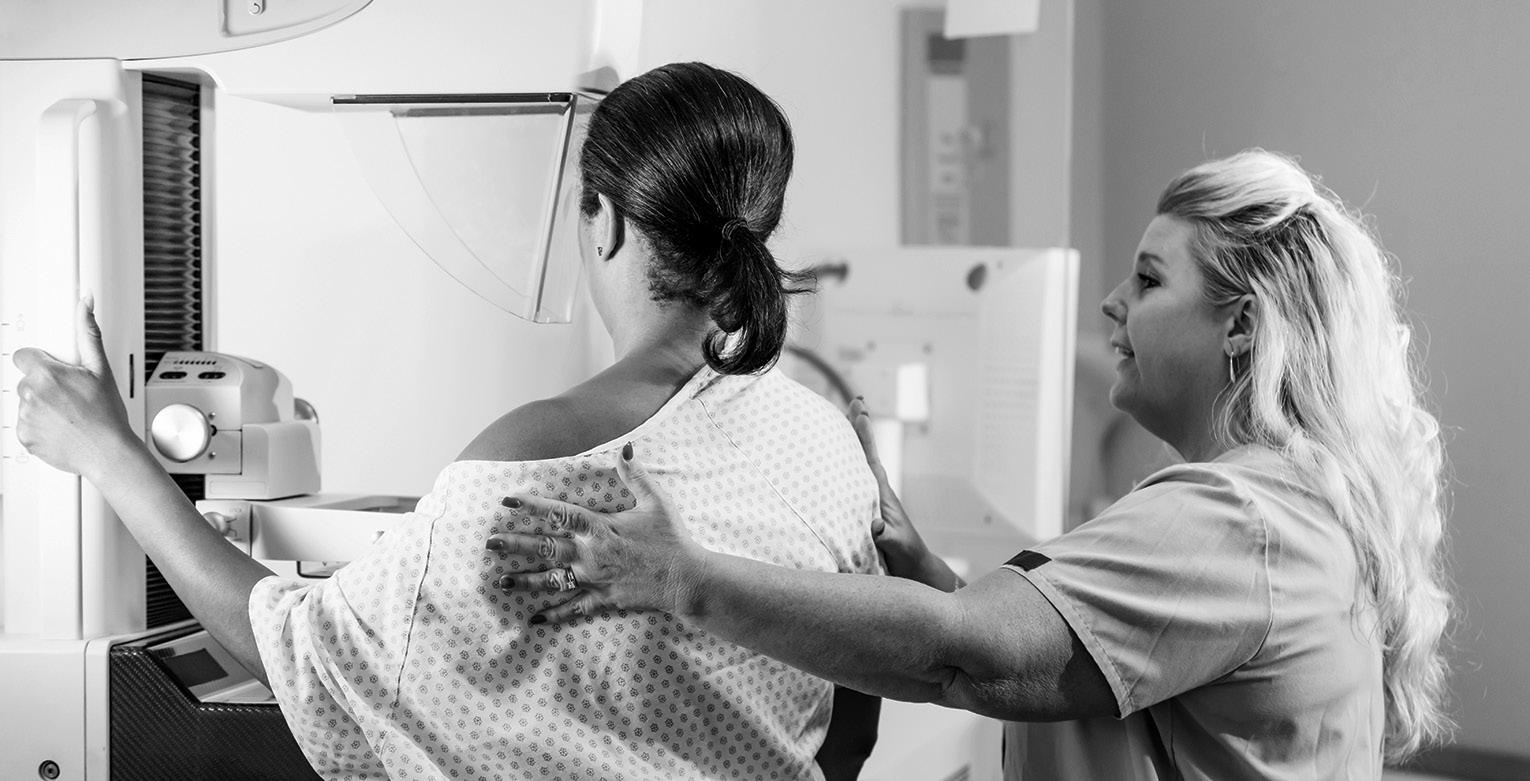Health Quarterly







• Discussing which birth control option is best for you
• Discussing ways to prevent sexually transmitted infections, including getting the HPV vaccine
• Screening for sexually transmitted infections, cervical cancer (e.g., Pap test) or other conditions based on personal risk and health history
• Identifying common health concerns such as heavy menstrual cycles, uterine cramping, premenstrual symptoms, breast issues, libido issues or pain during intercourse
• Discussing needs for planning a healthy pregnancy
• Offering pelvic physical therapy for patients with prolapse, pain or incontinence
• Helping navigate menopause symptoms with hormone and nonhormonal treatments
• Receiving breast and pelvic examination from the OB-GYN
During your visit, the doctor can also assess for other conditions or issues that may warrant a referral to different specialists, including acne or other skin concerns, enlarged thyroid, blood pressure and heart rhythm abnormalities, mood issues and urologic issues such as incontinence.
What is a perimenopause and menopause?
Two million women in the U.S. enter menopause each year. Menopause is defined as not having had a menstrual cycle for one year. The average
age for menopause is 51 years old. Perimenopause is the 7-10+ years before menopause when hormone levels decline, with 80% of women having bothersome symptoms, according to the National Institutes of Health (NIH). Some women experience symptoms as young as 35 years old. Postmenopause is the rest of your life after menopause. Hormone deficiency symptoms can continue for an average of about 7½ years, sometimes up to 12 years after symptoms first begin.
Hot flashes and night sweats are the typical symptoms that people associate with menopause. Other symptoms may include difficulty sleeping and insomnia, often due to the night sweats, leading to decreased energy reserve and fatigue. Women also experience brain fog, fuzzy thinking, decreased memory, difficulty concentrating, depression and anxiety, mood swings, tension, nervousness, headaches, bloating and abdominal weight gain, thinning of hair, palpitations sometimes with chest pain, vertigo, lower extremity swelling and achy joint pains.
Genitourinary symptoms of menopause (GSM) develop over time due to low estrogen levels. These symptoms include vaginal dryness, itching, discharge and even bleeding. Women begin to experience painful intercourse and loss of sexual desire, urinary bladder discomfort, more frequent urinary tract infections (UTI) and even overactive bladder symptoms like frequency and urge.
Long-term estrogen deficiency contributes to osteoporosis that affects 35% of women over the age of 80. Two million
fractures every year result in 500,000 hospitalizations in the U.S., according to the NIH. The most serious can lead to a need for long-term care and significant loss of mobility or mortality.
What are some of the ways to help navigate menopause?
Medical experts generally agree that women younger than 60 or those who are within 10 years of menopause onset and have no other concerning symptoms or conditions, the benefit risk ratio of hormone replacement therapy (HRT) is favorable for treatment. This can include treatment for symptoms or premature menopause, and it has also been shown to decrease bone loss and fracture. A recent study from the April 2024 journal Menopause, cites the benefits of continuing low dose transdermal or vaginal bioidentical estrogen replacement therapy in women even beyond age 65.
FDA-approved bioidentical estrogen and progesterone hormones are available. These hormones are different from earlier studied hormones that showed concerns. Many non-hormonal menopause medications also exist for those who are not good candidates or choose not to use HRT.
Men have long benefited from FDA-approved medicines for erectile dysfunction and topical testosterone for low testosterone levels. Premenopausal women now also have FDAapproved medicines available for low libido. Other treatment options are available as well, so discuss your choices with your OB-GYN.

Are there any other health benefits of Hormone Replacement Therapy?
Many studies have shown other benefits of HRT, although they are not FDA approved. Findings suggest women generally live three years longer on HRT than without HRT. Benefits for heart health, cognitive
function, mood, colon health, joint pains and even less diabetes make for better quality of life.
Do you have more questions about women’s health?
SIU Medicine drives innovative, forwardthinking research and best-practice clinical care
for women from all walks of life. Our providers will be your advocate, confidant and guide throughout your health care journey. If you have concerns about your health or are advocating for a female loved one, contact SIU Medicine today by calling 217-5458000 or 217-243-8455 In Jacksonville to schedule an appointment.



Hearing loss is one of the most common health issues in the over 50 age cohort. About 15% of the 45-64 tear old age group and 27% of the 65-74 age ground have significant hearing loss, according to the National Health Interview Survey. Only hypertension and arthritis are more common.
Despite its prevalence, hearing loss often goes undetected -at least by the person with hearing loss. Family and friends usually become more aware of the communication problems first. Family issues may the develop because of the individual’s refusal to accept the possibility of hearing loss.
Although many people are unwilling to admit they have a hearing loss, there are good reasons why the person with the hearing loss is “the last one to know”
Hearing loss is invisible Ther are no physical signs of hearing loss.
Hearing loss is gradual.
Hearing loss develops so slowly that the individual is not aware of any change. A loss may develop at the rate of one decibel a year. That is a daily rate of .001% of hearing, so its not surprising that the change is not noticed. But 10-20 years of this gradual loss results in a significant loss. Of course, exceptions to this are constant loud noise exposure, ear disease, infection, and acoustic trauma.
Painless Rarely is there any feeling of pain or discomfort associated with an adult-onset hearing loss. Contant or intermittent tinnitus may be the noticeable sign of hearing loss.
Partial Hearing Loss. In the early stage of adultonset hearing loss, hearing for low frequency sounds usually not affected, even as the ability to hear high frequency “speech clarity “sounds diminish. The absence of the high frequency sounds reduces the ability the hear consonants, women, and
children’s voices which the individual will report that “I can hear but not understand.” Family physicians need to take a more active role when questioning their patients hearing. It is not likely the patient will bring it up during the visit but family members often do.
reduced stress, reduced cognitive decline and dementia, improved social interaction and not least of all, better communication. Hearing is like our vision; we never know how bad it is until we get it evaluated. I remember when I had a need for glasses when my 40’s I went the race track with my sister and when I could not read the tote board, she gave me her glasses and what a difference it made! Schedule an appointment for a hearing test. It is quick, painless and could change your life Article Submitted by: centrAl illinoiS HeAring
All adults over the age of 55 should seek a baseline hearing test. Many insurance plans now cover this service and, in some cases, the hearing aids themselves because of the many benefits hearing aid use can provide such as

Few things can be as distracting as a beautiful day. When the weather outside is welcoming, it can be hard to focus on indoor activities, including work and tasks around the house. Though it’s not advisable to ignore responsibilities at work and at home when the weather outside beckons, it can be beneficial to spend ample time in nature when circumstances allow.
People tend to flock to the great outdoors in spring, summer and fall, and some are even so devoted that they bundle up and head outside throughout winter. Whether they know it or not, people who love to spend time in nature are doing their mental

and physical health a lot of good by embracing the great outdoors.
The National Alliance of Mental Illness notes that a growing body of research supports the idea that time in nature is good for mental health. A 2015 study from researchers at Stanford University found that people who walked in a natural area for 90 minutes exhibited decreased activity in a region of the brain associated with depression compared to those who walked in high-traffic urban settings.
The United Kingdom-based Mental Health Foundation also touts the

mental health benefits of the great outdoors. According to the MHF, research shows that people who are connected with nature are more likely to report their lives are worthwhile than those with no such connectedness. In addition, the MHF notes time in nature has been shown to generate positive emotions, including calmness and joy, and promote greater creativity.
When seeking to capitalize on the mental health benefits of time in nature, people should know that where they spend time outdoors matters. As the Stanford study indicated, time outside in high-traffic urban settings may not produce as profound



an effect as time spent in natural settings, like forests, that tend to be more serene. People who live in cities or other densely populated areas can still benefit from time outdoors, but they might experience even greater health gains if they make consistent efforts to spend time in more natural settings.

The physical health benefits of time in nature are equally notable. Perhaps the most obvious physical benefit is related to physical activity. People tend to
embrace physical activity when spending time in nature. Hiking, jogging, walking, nature-based recreational activities like kayaking, and playing sports like basketball or pickleball all involve physical activity, which can help people avoid the consequences of a sedentary lifestyle, such as an increased risk for chronic diseases.
More specifically, the New York State Department of Environmental Conservation notes the physical health benefits of spending time outside include:
· A stronger immune system
· Lower blood pressure
· Increased energy levels
· Improved sleep
Each of those benefits contributes to greater overall health, making time outdoors among the more beneficial behaviors a person can embrace.
There’s no shortage of benefits to spending time in nature. That’s something to keep in mind the next time welcoming weather beckons you to get some fresh air.
The phrase “get some sun” is heard far and wide between the months of May and September. Many people spend much of their weekends outdoors between Memorial Day and Labor Day, and that means exposure to the sun.
As the mercury rises and more and more people emerge from their winter and early spring hibernation, a rundown of the link between sun exposure and skin cancer can remind readers of the need to exercise caution when heading outdoors in the months to come.
Sun and skin cancer risk
Exposure to the sun is a risk factor for skin cancer. According to the Ameri-
can Institute for Cancer Research (AICR), exposure to ultraviolet radiation is the primary cause of skin cancer. Ultraviolet radiation comes from natural sources, like the sun, but also from artificial sources like tanning beds. The AIM at Melanoma Foundation notes that exposure to the ultraviolet radiation is the main risk factor for melanoma, which the Melanoma Research Alliance notes is the deadliest form of skin cancer.
Does past exposure affect my risk today?
AIM at Melanoma notes that cumulative sun exposure and episodes of severe sunburns increase the risk of developing melanoma. According to the Skin Cancer Foundation, research

has shown that the UV rays that damage skin also can alter a tumor-suppressing gene, giving cells less of a chance to repair before a progression to cancer takes place.
A single blistering sunburn in childhood or
adolescence more than doubles a person’s risk of developing melanoma later in life, while five or more sunburns more than doubles that risk as well. The damage to skin caused by a sunburn is indeed cumulative, so the more sunburns a person gets,
the greater that person’s risk of developing skin cancer becomes.
So is a tan detrimental to overall health?
AIM at Melanoma notes that the tan many people hope to get and keep
throughout late spring and summer is detrimental to their overall health. AIM notes that a tan develops when the skin tries to protect itself from UV rays by producing pigment as a protective shield. The more pigment the body produces, the darker the skin becomes. So a tan is evidence that the skin has been damaged by exposure to UV radiation. In fact, AIM notes that each time a person develops a tan, that individual’s risk of developing skin cancer increases.
Spring and summer weather beckons people outside each day. When that call comes, individuals must make an effort to protect their skin from overexposure to the sun.









